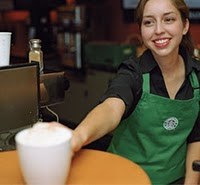
SERVICE-PRODUCT BUNDLE
The three elements of the service bundle are explicit service, implicit service, and facilitating goods. In the case of Starbucks the explicit service is accuracy and receiving relatively quick assistance. The implicit service refers to how the customers feel about the environment the way workers treat them and how the surroundings add to a pleasant experience. The facilitating goods are the foods and beverages consumed that should be made to how the customers asked for it. This is what should be followed before a good is delivered to appeal to customers and have them return.
SERVICE MATRIX
On the Customer wants and needs in the service package Starbucks uses Standard with options; using moderately repeatable sequence. Customer has some decision making power. This is evident as though customers have the ability to customize their coffee specifically for them, the choices they have are standardized; somewhat mass customization. On the operations service process design Starbucks uses a limited number of process pathways. Line flows, low work complexity. As explained in the process selection section, Starbucks uses a line flow process. All coffee is made in a sequential order; following the same format repeatedly. Hence Starbucks falls into the Co-routed services section of the matrix as it offers a moderate number of choices to customers using moderately standardized processes.

CUSTOMER CONTACT
Starbucks interacts with customers in two ways. The first way is at the Point of Sale (POS). The interaction with the customer begins with a greeting, followed by taking the drink/food orders, money exchange, and a farewell. Pleasant conversation is encouraged, especially with the regular customers. This builds the idea of the third home: Starbucks's phrase for its ambiance meaning that a person has their house, their work, and their Starbucks to make them feel comfortable. The second interaction is taken place over the phone or by email concerning questions, comments, or complaints that they might have. During the the first set of interactions the customer has a high level of involvement. The customer has all the choices in how they would like their drink made. Also, the entire interaction take place face-to-face making the interaction more personal for the customer. There is no self-service or technology used in these interactions. The second interaction, has medium involvement with the customer and has no face time.
Starbucks supports its partners in several ways. The support starts with it supervisor team. These partners are trained with deployment maps. These maps tell the supervisor where every person should be placed on the floor at any given time based on the number of people on the floor. Also, the maps tell what each person is responsible for while they are working. This helps eliminate confusion, as well as control the possible variability that the customers can create with their orders. The baristas are also trained with various different acronyms that tell the barista how to handle many situations they may run into, as well as easy ways to remember information about different products.
SERVICE RECOVERY
If a situation does arise, Starbucks has several different ways to rectify the situation. The first way is with their guarantee. This guarantee is that a customers drink should be made right every time. If not let your barista know and they will be happy to remake it for you. This is also called, within company, a right now recovery. This allows the barista to remake the drink to any specifications that were missed in the previous attempt. If the right now recovery is not enough to fix the situation, the barista can give the customer a recovery certificate.

This is a coupon that allows the customer to recieve any drink of their choosing for free. Finally Starbucks also has the store managers as well as the district managers leave their business card in the store. This allows the customer to have direct communication with the management if any situations become out of hand.

 Starbucks corporation has a variety of projects ranging from developing a new type of drink to renovating a location. For the purpose of this blog we will focus on a single retail location of the company. Starbucks retail outlets only really has two projects. These projects are building/renovating stores and operations changes. This blog will focus on a recent operations change that just occurred. The project is repeatable routine of beverages.
Starbucks corporation has a variety of projects ranging from developing a new type of drink to renovating a location. For the purpose of this blog we will focus on a single retail location of the company. Starbucks retail outlets only really has two projects. These projects are building/renovating stores and operations changes. This blog will focus on a recent operations change that just occurred. The project is repeatable routine of beverages. 













 Inventory is described as “ a stock of materials used to facilitate products or satisfy customer demands.” Typical inventories include raw materials, works in progress and finished goods. (pg 363 of the text)
Inventory is described as “ a stock of materials used to facilitate products or satisfy customer demands.” Typical inventories include raw materials, works in progress and finished goods. (pg 363 of the text)





